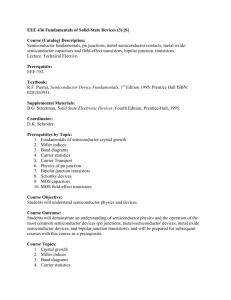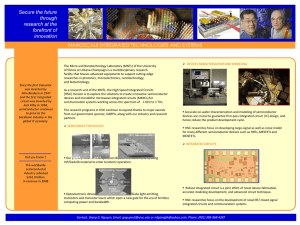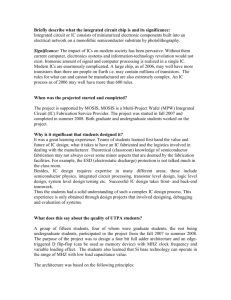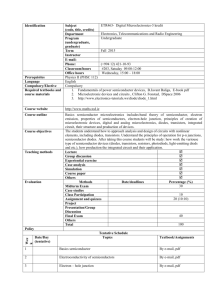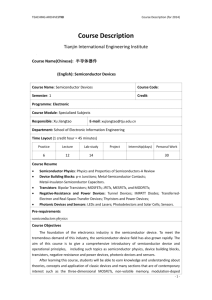Crystal Growth through Solid Metal An attempt to understand a relatively
advertisement
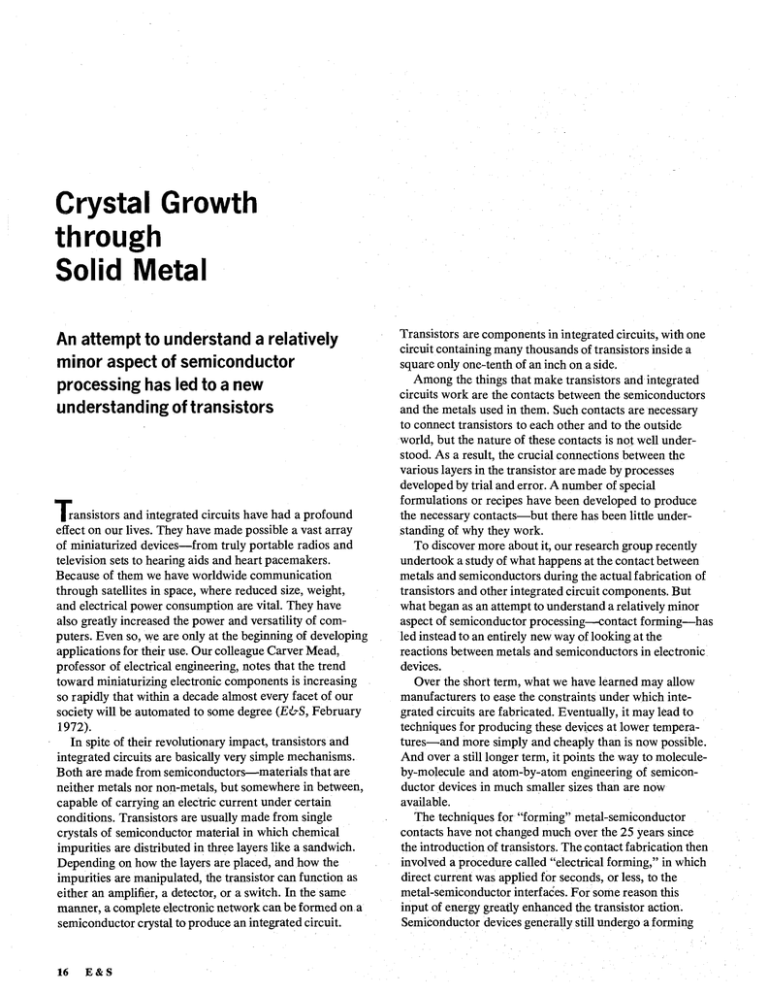
Crystal Growth through Solid Metal An attempt to understand a relatively minor aspect of semiconductor processing has led to a new understanding of transistors Tansistors and integrated circuits have had a profound effect on our lives. They have made possible a vast array of miniaturized devices-from truly portable radios and television sets to hearing aids and heart pacemakers. Because of them we have worldwide communication through satellites in space, where reduced size, weight, and electrical power consumption are vital. They have also greatly increased the power and versatility of computers. Even so, we are only at the beginning of developing applications for their use. Our colleague Carver Mead, professor of electrical engineering, notes that the trend toward miniaturizing electronic components is increasing so rapidly that within a decade almost every facet of our society will be automated to some degree ( E b S , February 1972). In spite of their revolutionary impact, transistors and integrated circuits are basically very simple mechanisms. Both are made from semiconductors-materials that are neither metals nor non-metals, but somewhere in between, capable of carrying an electric current under certain conditions. Transistors are usually made from single crystals of semiconductor material in which chemical impurities are distributed in three layers like a sandwich. Depending on how the layers are placed, and how the impurities are manipulated, the transistor can function as either an amplifier, a detector, or a switch. In the same manner, a complete electronic network can be formed on a semiconductor crystal to produce an integrated circuit. Transistors are components in integrated circuits, with one circuit containing many thousands of transistors inside a square only one-tenth of an inch on a side. Among the things that make transistors and integrated circuits work are the contacts between the semiconductors and the metals used in them. Such contacts are necessary to connect transistors to each other and to the outside world, but the nature of these contacts is not well understood. As a result, the crucial connections between the various layers in the transistor are made by processes developed by trial and error. A number of special formulations or recipes have been developed to produce the necessary contacts-but there has been little understanding of why they work. To discover more about it, our research group recently undertook a study of what happens at the contact between metals and semiconductors during the actual fabrication of transistors and other integrated circuit components. But what began as an attempt to understand a relatively minor aspect of semiconductor processing-contact forming-has led instead to an entirely new way of looking at the reactions between metals and semiconductors in electronic devices. Over the short term, what we have learned may allow manufacturers to ease the constraints under which integrated circuits are fabricated. Eventually, it may lead to techniques for producing these devices at lower temperatures-and more simply and cheaply than is now possible. And over a still longer term, it points the way to moleculeby-molecule and atom-by-atom engineering of semiconductor devices in much smaller sizes than are now available. The techniques for "forming" metal-semiconductor contacts have not changed much over the 25 years since the introduction of transistors. The contact fabrication then involved a procedure called "electrical forming," in which direct current was applied for seconds, or less, to the metal-semiconductorinterfaces. For some reason this input of energy greatly enhanced the transistor action. Semiconductor devices generally still undergo a forming by James 0. McCaldin and James W. Mayer Thin layers of metal are evaporated onto semiconductor crystals in this metal evaporation chamber-the first step in a new and simpler way of producing transistors. The process was developed by McCaldin (left) and Mayer, working with research fellows Gianpiero Ottaviani and Dug Sigurd and graduate students Vince Marrello and Haluk Sankur. process, but today it involves heat treatment to temperatures near 500 degrees Centigrade. In a macroscopic sense, a formed contact provides the necessary electrical capabilities for semiconductor devices like transistors. (Note for the specialist: The formed contact can be either a good ohmic contact, a blocking contact, or a contact capable of injecting minority carriers.) However, the physical processes that lead to the behavior observed at the contacts are determined over extremely small dimensions-so small, in fact, that it takes instruments with considerably higher resolving power than optical microscopes to observe what is happening. Fortunately, there are at least three kinds of instruments with the necessary resolving power available at Caltech and the Jet Propulsion Laboratory. First, there are the scanning electron microscopes, which are used routinely to distinguish structures of sub-optical size-usually at resolutions 10 to 30 times finer than that of the best optical microscopes. To supplement the information provided by the electron microscopes, there is the electron microprobe, which can identify local atomic composition and detailed movements of atoms at the metal-semiconductor interface. Finally, there is the million-electron-volt accelerator at the Kellogg Radiation Laboratory, which is capable of resolving atom depth distributions to within a few hundred Angstroms (an Angstrom being fourbillionths of an inch long). In the latter case, the accelerator is used for depth microscopy rather than for the lateral resolution provided bv the electron microvrobe. Using these instruments, our group found-to our surprise-that atoms move across the metal-semiconductor interface at temperatures as low as that of boiling water. For example, silicon moves through a thin film of gold about 1,000 Angstroms thick in a few minutes at 100 degrees Centigrade. Only in rare instances do atoms move through a solid medium at such a low temperature. We have found it possible to grow semiconductor crystal layers by utilizing the fact that semiconductor atoms move through solid metal films. To illustrate what June 1973 17 SOURCE In transistors, the necessary contacts between metals and semiconductors can be grown by a process very similar t o growing crystals in a liquid-though on a much smaller scale. I f , for example, solid material is dissolved in a beaker filled with a liquid, it is transported t o the seed crystal at the bottom of the beaker, where the crystal grows in an orderly, regular fashion. The solid phase growth o f metal-semiconductor contacts occurs in the same way (below). The layer o f loosely arranged semiconductor on top provides a source o f material that dissolves in the solid metal and is transported to the seed crystal below. There it rearranges itself into a form necessary for transistor action. All of this happens in a space with a thickness of less than one micronfour hundred-thousandths of an inch. . D l FFUSION 1 GROWTH I 0 SOURCE I - (1 2 1 A simple way to build a transistor is to evaporate aluminum on both sides of a thin wafer of n-type germanium and heat it to 150 degrees on a hot plate is going on in this case, we can go back to a well-known experiment from high school chemistry-growing solid crystals in a liquid solution. A beaker filled with a liquid is fed from the outside with loose grains of sodium chloride-ordinary table salt-for example. The grains dissolve in the liquid, which allows the salt atoms to diffuse to the bottom of the beaker where a "seed" crystal has been placed. The seed is usually a solid crystal of the same material as that dissolved in the liquid-in this case, salt. But it may be of any composition as long as it has an orderly, crystalline shape for the dissolved salt to stick to and re-arrange itself. The seed will grow, fed by the dissolved salt. In a similar manner, semiconductor crystals capable of exhibiting transistor action grow through a solid metal film which takes the place of the liquid in the beaker. The film provides a medium through which the nutrient material is dissolved. The nutrient-a layer of loosely arranged semiconductor material on the metal surfaceis unable under normal conditions to rearrange its atoms into the regular crystalline form necessary for transistor action to take place. We have assumed for many years that it was necessary to supply quite a bit of extra energy-either through application of direct current or by heating to hundreds of degrees-to make this rearrangement occur. But we have made this assumption without understanding the key role of the metal film. The solid metal enables the disorderly semiconductor material to dissolve and diffuse, atom by atom, to a crystalline substance on the bottom of the metal-semiconductor sandwich. The function of this crystal is the same as that of the seed in the liquid: to provide a template for further crystal growth. We refer to the technique as solid phase epitaxy. We have demonstrated this process in the laboratory with germanium-aluminummixtures where the diffusion temperature of these atoms is strikingly low. We have obtained transistor action at the contacts in a single treatment at temperatures just slightly above that of boiling water. One of the simplest ways to build a transistor is as follows: Take a thin wafer of n-type germanium, evaporate aluminum on both sides, and heat it to 150 degrees on a hot plate. When removed from the hot plate, the structure clearly exhibits transistor action. By comparison, the technology currently in use requires much higher temperatures, excruciatingly clean environments, and special mixtures of gases to protect the semiconductors during the fabrication process. The solid phase epitaxy technique is much simpler. We believe that our newly developed technique will speed up the trend to smaller and smaller transistors and semiconductor devices. A typical integrated circuit chip is about a tenth of an inch long and a tenth of an inch wide. The size of this chip will not change. What will change is the number and size of the transistors that can be put on the chip. Where we can now fit as many as 10,000 components on a standard chip, we will soon be able to put 100,000-or a million. Most of the progress in this direction has been made by reducing the length and width (the lateral dimensions) of the transistors. As the ability to reduce the lateral dimensions of transistors develops, we need to develop a comparable ability to reduce their depth dimensions. They should be no larger than required by the electronic functions performed-in contrast to the present thicknesses, which are artificially large because of the limitations of current technology. Our studies indicate that the behavior we have observed in the metal-semiconductor contacts arises from structures that are much smaller than anyone has supposed. The thicknesses produced by the techniques we have developed are typically from a maximum of 3,000 Angstroms down to as thin as we can measure with present instrumentation -a few hundred Angstroms. This means that our solid-state metal-semiconductor sandwiches have dimensions much closer to what nature requires to obtain the necessary electronic functions. With improvements in instrumentation and fabrication skills, it may soon be possible to reduce this thickness to, perhaps, atomic dimensions. rRLI-ITiASE EPITAXIAL The silicon mesa in the scanning electron micrograph (top) is only 12 millionths of an inch high and 16 hundred-thousandths of an inch wide. It was grown from a solid aluminum film by the process illustrated below. An oxide mask is placed on the silicon where epitaxial growth is not supposed to occur. Over it is evaporated a thin layer of aluminum containing silicon. Where the metal touches the original surface o f the silicon, crystal growth occurs by silicon atoms depositing onto the crystal substrate. This grown structure is just the form necessary for transistor action. The process is called solid phase epitaxial growth. June 1973 19

